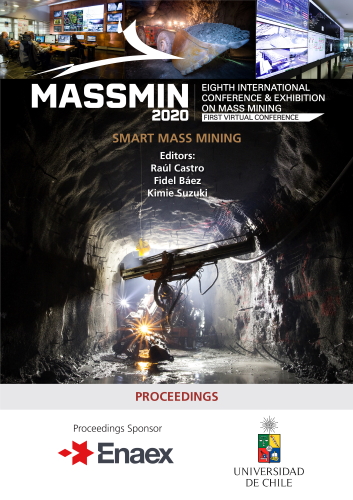Secondary rock ore reserve recovery using a primary rock layout: Extensión Hw Pipa Norte, a case study

|
Authors: Hidalgo, F; Salinas, I |
This paper is hosted with the kind permission of Lulea University of Technology, International Conference & Exhibition on Mass Mining, 2024.
DOI https://doi.org/10.36487/ACG_repo/2063_06
Cite As:
Hidalgo, F & Salinas, I 2020, 'Secondary rock ore reserve recovery using a primary rock layout: Extensión Hw Pipa Norte, a case study', in R Castro, F Báez & K Suzuki (eds), MassMin 2020: Proceedings of the Eighth International Conference & Exhibition on Mass Mining, University of Chile, Santiago, pp. 155-165, https://doi.org/10.36487/ACG_repo/2063_06
Abstract:
For Panel Caving mine projects, extraction level design plays a crucial role in determining productivity and the amount of investment required. In existing literature regarding gravitational flow of broken ore, the general rule of thumb is that the finer the fragment size of the rock, the closer the drawpoints need to be. This is in order to maximize ore recovery through interactive draw between the drawpoints. In the present study, we analyze a particular case that serves as an exception to this general rule. The case involved is a subsector of El Teniente Mine in Chile, called Extensión Hw Pipa Norte (EHPN), where the layout is spaced 20 m between drawpoint drifts and 30 m between production drifts. The predominant rock type is secondary rock, which has a mean fragment size below 25 cm. With this layout and rock combination, a low reserve recovery (below 90%) is expected since the draw ellipsoids are expected to interact at great height, thus leaving a considerable amount of remnant ore left unmined above the crown pillars. In order to measure ore reserve recovery, we calculate the quotient between extracted ore and planned reserves, the latter selected and estimated through various technical and economic criteria during the pre-production planning phase. Reserve recovery is calculated for the sector as a whole, as well as for each individual drawpoint. Results indicate a total of 97% reserve recovery for EHPN as a whole, while 70% of the drawpoints managed to exceed 90% in individual recovery. These numbers prove quite interesting, as a more spaced layout reduces the amount of drift development requirements for the same amount of footprint area, which means a lighter investment for the same level of income. Furthermore, a more spaced layout generates more resistant crown pillars, which in turn allows for the construction of larger drifts and thus allows for the use of larger haulage equipment. This has a direct positive impact on productivity. It is worth noting that the base of the exploited block is composed of primary ore, while the rest of the block is predominantly composed of secondary ore. Due to this, combined with what was discussed above, delving deeper into the physical phenomenon behind this case should prove useful to validate and extend its applications to future mining projects with similar characteristics.
References:
Castro, R, De la Huerta, F & Vargas, R 2012, ‘Determination of drawpoint spacing in panel caving: a case study at the El Teniente Mine’, The Journal of The Southern African Institute of Mining and Metallurgy, vol. 112, pp. 871-876.
Cavieres, P, Contreras, E & Arce, JC 2005, ‘Dimensionamiento de mallas de extracción, bateas recolectoras y pilar corona para método Panel Caving en roca primaria’, Annual mining engineering symposium, Universidad de Santiago, in Spanish.
Laubscher, DH 1994, ‘Cave mining – the state of the art’, The Journal of The Southern African Institute of Mining and Metallurgy, vol. 94, pp. 279-293.
© Copyright 2025, Australian Centre for Geomechanics (ACG), The University of Western Australia. All rights reserved.
View copyright/legal information
Please direct any queries or error reports to repository-acg@uwa.edu.au
View copyright/legal information
Please direct any queries or error reports to repository-acg@uwa.edu.au
